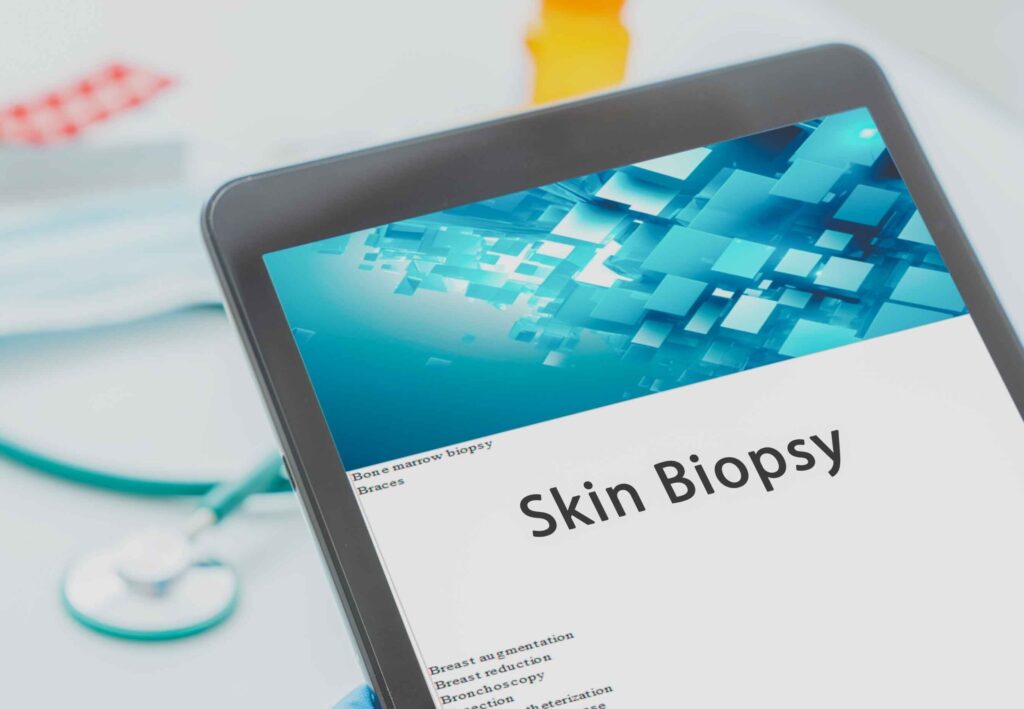A skin biopsy is a medical procedure in which cells are removed from the surface of your body and examined under a microscope to help with diagnosis and treatment of various skin conditions. It’s commonly used to evaluate suspicious moles, growths, and skin cancer, as well as to confirm blistering disorders and other chronic skin diseases.
What Is a Skin Biopsy and Why Is It Performed?
Understanding the right type of skin biopsy helps dermatologists make accurate diagnoses and recommend the most effective treatment. If you notice changes in your skin or have a suspicious lesion, consulting a specialist is key to timely detection and care.
If you have a suspicious skin condition, you can consult the best dermatologist in East New York and inquire about our skin biopsy service at Doral Health and Wellness Dermatology Center.
Types of Skin Biopsy Procedures
There are several types of skin biopsy procedures, each serving a specific diagnostic purpose in dermatology. The right biopsy type depends on factors such as the size, depth, location, and characteristics of the skin lesion. Here are some of the most commonly used methods:
Punch Biopsy
Procedure: A small, circular tool (punch) is used to remove a full-thickness cylindrical tissue sample that includes the epidermis, dermis, and superficial fat.
Purpose: Ideal for diagnosing inflammatory skin conditions, suspicious pigmented lesions, and diseases requiring a deep tissue sample such as lupus or psoriasis.
Shave Biopsy
Procedure: A scalpel or flexible razor is used to shave off a superficial layer of skin, including the lesion or abnormal area.
Purpose: Often used for elevated, superficial skin lesions like warts, seborrheic keratosis, or basal cell carcinoma. It’s less invasive and does not require sutures.
Excisional Biopsy
Procedure: The entire lesion and a margin of surrounding skin are surgically removed using a scalpel. Sutures are usually required.
Purpose: Preferred when a full tissue analysis is needed or when skin cancer (like melanoma) is suspected. This method is both diagnostic and potentially therapeutic.
Incisional Biopsy
Procedure: Only a portion of the lesion is removed, typically when the area is too large or complex to remove entirely.
Purpose: Useful for sampling large rashes, tumors, or ulcerated skin areas. It provides sufficient tissue for diagnosis without removing the entire lesion.
Fine Needle Aspiration (FNA)
Procedure: A fine, hollow needle is used to withdraw cells or fluid from a skin lesion, cyst, or underlying mass.
Purpose: Typically used for subcutaneous nodules, cysts, or to evaluate lymph nodes. It’s minimally invasive but provides limited tissue architecture.
Scrape Biopsy (Curettage)
Procedure: A spoon-shaped instrument (curette) scrapes off superficial skin tissue.
Purpose: Often used to evaluate superficial skin conditions, including actinic keratosis and some types of non-melanoma skin cancers like squamous cell carcinoma.
Brush Biopsy
Procedure: A soft brush collects cells from the lesion’s surface.
Purpose: This less invasive technique is commonly used for suspicious but hard-to-access lesions. It’s useful for preliminary screening before more invasive biopsies.
Tzanck Smear
Procedure: Cells are scraped from the base of a vesicle or blister and stained for microscopic evaluation.
Purpose: Useful in diagnosing viral infections such as herpes simplex virus (HSV), herpes zoster, or autoimmune conditions like pemphigus vulgaris.
Lymph Node Biopsy
Procedure: If skin cancer (like melanoma) is suspected to have spread, a nearby lymph node is surgically removed for testing.
Purpose: Helps determine the stage of cancer and guides further treatment decisions. It’s crucial for staging and prognosis in advanced cases.
These various skin biopsy types allow dermatologists to detect a wide range of conditions, from benign lesions to serious diseases like melanoma. If you’re experiencing unusual skin growths or lesions, it’s essential to consult a dermatologist who can determine the best biopsy method for an accurate diagnosis and personalized treatment.
Preparing for Your Skin Biopsy: What to Expect
The choice of skin biopsy type will depend on various factors, including the suspected condition, lesion characteristics, and the depth of tissue needed for a more accurate diagnosis. Dermatologists or other medical providers will determine the most appropriate biopsy method based on the specific case.
Before the procedure, your healthcare provider will review your medical history, including any allergies, medications (especially blood thinners), and existing skin conditions. You may be advised to avoid certain medications or supplements to reduce the risk of bleeding or bruising.
In most cases, a skin biopsy is done under local anesthesia to numb the area, so you should not feel pain during the procedure—only slight pressure or tugging. Depending on the type of biopsy (shave, punch, incisional, or excisional), the process may take only a few minutes.
It’s also important to wear loose-fitting clothing if the biopsy site is in a sensitive or hard-to-reach area, and to follow any instructions given to you beforehand, such as avoiding lotions or creams on the target area.
By understanding the steps and preparing accordingly, you can help ensure a smooth procedure and faster recovery.
If you have a skin condition that needs skin biopsy, you can consult the best dermatologist in East New York. At Doral Health and Wellness Dermatology Center, we also treat different types of chronic skin conditions. Our dermatologists are equipped with the right knowledge and expertise to help you treat and manage your chronic skin condition. You can visit us at 1797 Pitkin Avenue, Brooklyn, New York, 11212, to schedule an appointment. You can also call us at 1-347-384-5690 or visit our website at https://www.bestbrooklyndermatologist.com.







